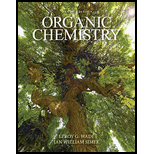
(a)
To determine: The effect on the reaction rate if the concentration of ethanol gets doubled in the given reaction of tert-butyl ether and ethanol.
Interpretation: The effect on the reaction rate if the concentration of ethanol gets doubled in the given reaction of tert-butyl ether and ethanol is to be predicted.
Concept introduction: The replacement or substitution of one
The nucleophilic reaction contains only a substrate as a reactant not a nucleophile which means a unimolecular nucleophilic reaction is termed as
(b)
To determine: The effect on the reaction rate if the concentration of tert-butyl ether gets tripled and the concentration of ethanol gets doubled in the given reaction.
Interpretation: The effect on the reaction rate if the concentration of tert-butyl ether gets tripled and the concentration of ethanol gets doubled in the given reaction is to be predicted.
Concept introduction: The replacement or substitution of one functional group with another different functional group in any chemical reaction is termed as substitution reaction. There are two types of substitution reaction. First one is electrophilic substitution reaction in which electrophile is present as a reagent and second one is nucleophilic substitution reaction in which nucleophile is present as a reagent.
The nucleophilic reaction contains only a substrate as a reactant not a nucleophile which means a unimolecular nucleophilic reaction is termed as
(c)
To determine: The effect on the reaction rate if the temperature of the given reaction gets raised.
Interpretation: The effect on the reaction rate if the temperature of the given reaction gets raised is to be predicted.
Concept introduction: The replacement or substitution of one functional group with another different functional group in any chemical reaction is termed as substitution reaction. There are two types of substitution reaction. First one is electrophilic substitution reaction in which electrophile is present as a reagent and second one is nucleophilic substitution reaction in which nucleophile is present as a reagent.
The nucleophilic reaction contains only a substrate as a reactant not a nucleophile which means a unimolecular nucleophilic reaction is termed as
Want to see the full answer?
Check out a sample textbook solution
Chapter 6 Solutions
Organic Chemistry Plus Mastering Chemistry with Pearson eText -- Access Card Package (9th Edition) (New in Organic Chemistry)
- Draw the products of the hydrolysis reaction between the ester molecule and water. Determine the products of the following reaction.arrow_forwardWhat is the unsaturation number for compounds with the formula C₂H₁₂Cl₂? O õ õ o o 4 3arrow_forwardIndicate the product obtained (formula). F3C. CF3 Br NH2 NH OMe K2CO3, DABCO, DMFarrow_forward
- What are the missing intermediates 1, 2, and 3? Please include a detailed explanation explaining the steps of malonic ester synthesis. Please include drawings of the intermediates and how they occur.arrow_forwardThe following intermediates are to proceed by acetoacetic ester synthesis. What are intermediates 1 and 2 plus the final product 3? Please include a detailed explanation and drawings of the intermediates and how they occurred.arrow_forwardThe chemical formula of "benzimidazole E" is C7H6N2. Draw it.arrow_forward
 Organic Chemistry: A Guided InquiryChemistryISBN:9780618974122Author:Andrei StraumanisPublisher:Cengage Learning
Organic Chemistry: A Guided InquiryChemistryISBN:9780618974122Author:Andrei StraumanisPublisher:Cengage Learning
